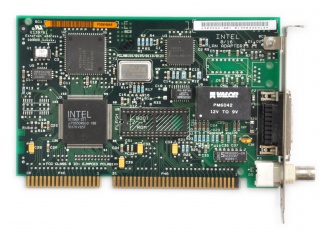Difference between revisions of "Intel 8∕16 LAN Adapter"
From Vogons Wiki
Malvineous (Talk | contribs) (Update infobox) |
(→Boot ROM) |
||
| Line 32: | Line 32: | ||
== Boot ROM == | == Boot ROM == | ||
| − | This card's boot ROM socket appears | + | This card's boot ROM socket appears takes a standard 32-pin EEPROM chip, as well as 28-pin EEPROM chips such as the 28C64. It has been tested extensively with the 28C64 chip flashed with XT-IDE BIOS images, both XT and AT versions. It is a reliable way to boot from a modern era hard drive connected to an XT or AT class system whose BIOS would not natively support it. |
The card's DOS drivers come with a configuration program (<tt>SOFTSET.EXE</tt>) that can be used to enable the ROM socket (it is disabled by default) and set the base address, as well as adjust all the usual options like the I/O address and IRQ. | The card's DOS drivers come with a configuration program (<tt>SOFTSET.EXE</tt>) that can be used to enable the ROM socket (it is disabled by default) and set the base address, as well as adjust all the usual options like the I/O address and IRQ. | ||
Revision as of 05:30, 23 April 2018
Intel 8∕16 LAN Adapter
| Bus type | ISA |
|---|---|
| Bus width | 16-bit |
| Bus speed | 8 MHz |
| 8-bit ISA compatible? | Yes |
| Manufacturer | Intel |
| Chipset | i82586 |
| Connectors | AUI, BNC |
| Requires -5VDC? | No |
| Requires -12VDC? | No |
| Config method | Software |
| Ethernet | |
| Boot ROM | Socket, 32-pin JEDEC, read-write |
| Driver | Missing download URL |
The Intel 8∕16 LAN Adapter is a 10Mbps network card.
Additional photos
Boot ROM
This card's boot ROM socket appears takes a standard 32-pin EEPROM chip, as well as 28-pin EEPROM chips such as the 28C64. It has been tested extensively with the 28C64 chip flashed with XT-IDE BIOS images, both XT and AT versions. It is a reliable way to boot from a modern era hard drive connected to an XT or AT class system whose BIOS would not natively support it.
The card's DOS drivers come with a configuration program (SOFTSET.EXE) that can be used to enable the ROM socket (it is disabled by default) and set the base address, as well as adjust all the usual options like the I/O address and IRQ.


